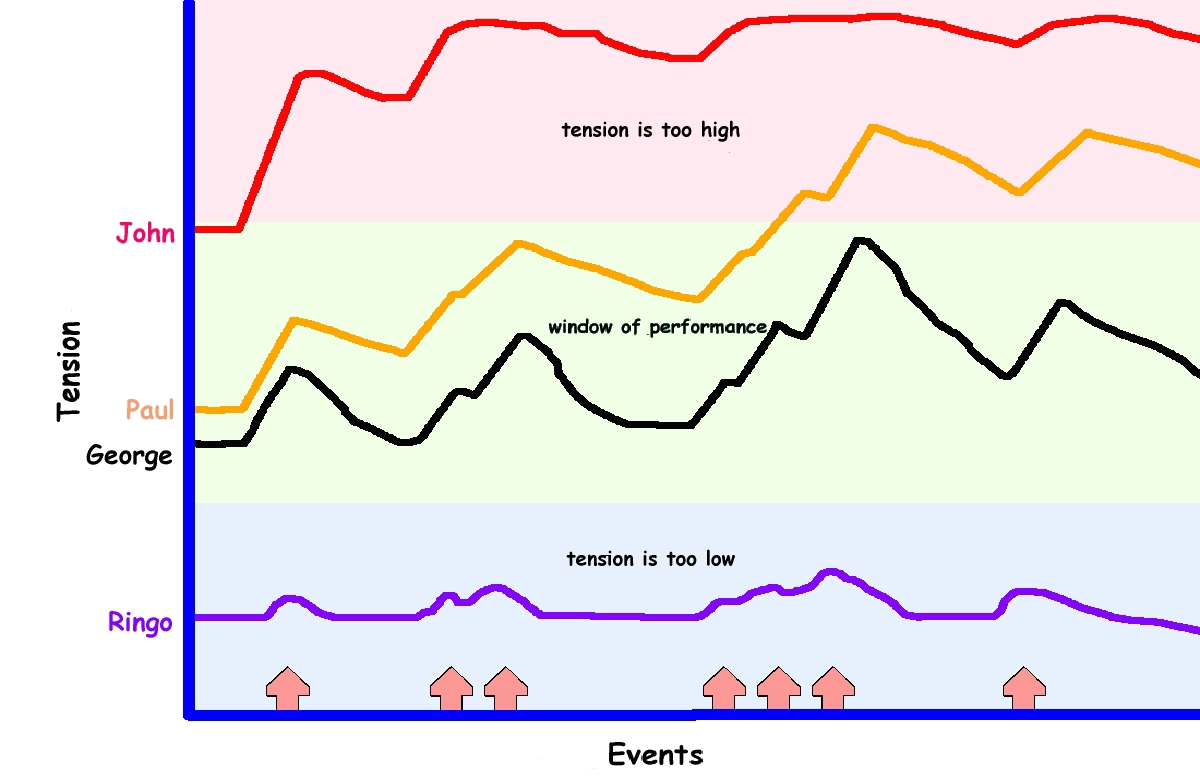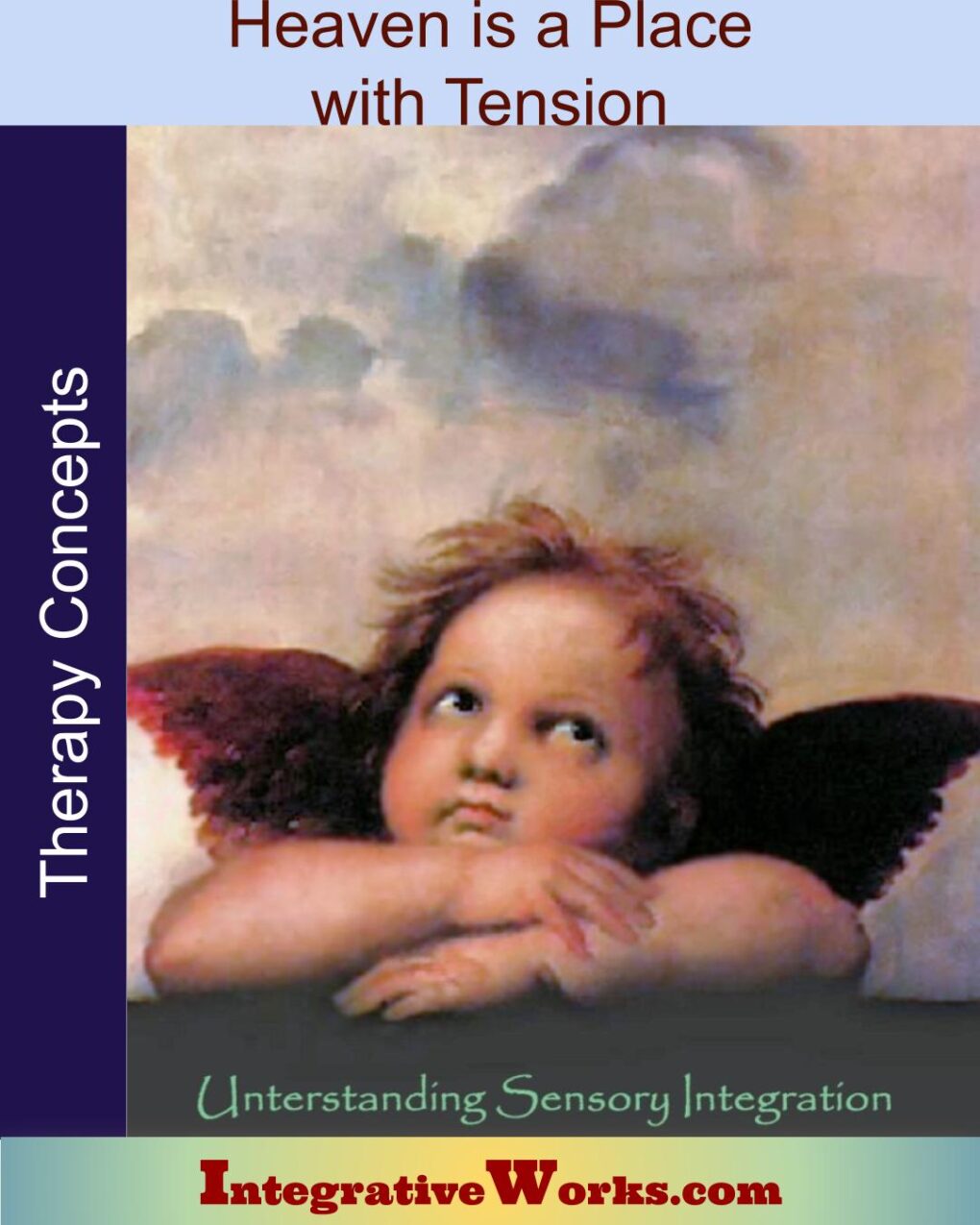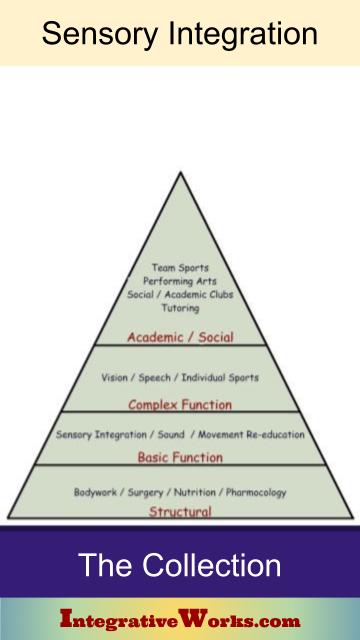Believable Lies
There are lies that we know are lies, but we play along. “I’ll call you.” “Baby, I think those jeans are just cut wrong.” “I knew nothing about that.” “You are the best, EVER.” “If we only made a little more money, we’d be happy.” “I was just checking her posture.” “I’d like to live a stress-free life.”
Although many of those would be great fodder for a blog, I’d like to explore the last one. I had a client the other day who was talking to me about religion. He said none of them made sense because heaven, paradise, or nirvana is always described as peaceful and easy. That sounded like hell to him. He said that we would be bored and unhappy if we didn’t have something interesting and a bit challenging. Okay, he IS a lawyer specializing in intense international negotiations, but still, I have to agree with him.
Bear with me…
The chart below is an adaptation of the original chart by the Sensory Integration icon, Julia Wilbarger. It is a simplified model of how events’ frequency and intensity change our tension level. First, there are events at the bottom. These events could be anything that evokes a response. A loud noise. A car pulling in front of you. The scratchy tag in your shirt. A child calling your name. A Starbucks latte. Comforting warm air. Muggy, humid air. An open refrigerator.
Next, the four lines show how different people might respond. People get overwhelmed or bored if tension is too high (red zone) or too low (blue zone). When this happens, they become less able to attend. They drop tasks, forget things, get grouchy, shut down, and otherwise can’t respond appropriately and/or move to the next task.
Notice the strong relationship between the response to events, the recovery from events, and the level of tension.

It’s a Hard Days Night
- George has the most steady rhythm in the group. He can blend in when it is exciting or when things are going slow because he gets back on track quickly. Look how George stays in the “window of performance” because he recovers better than Paul.
- If Paul had a faster recovery or a wider window of performance, Paul wouldn’t get out of sorts. He probably needs a complex fidget for his hands or some singing, and he’ll be fine.
- Everything stimulates John. First, he probably needs a complex fidget for his hands to calm himself and lots of singing. Next, he probably tries to control the group and calm things down. In the end, he may self-medicate until he just can’t take it anymore and finds a low-key partner.
- Ringo needs a lot of input and is looking for intensity, like something to beat on to help him pay attention. Ringo would do well on stimulants like Ritalin, which would jack him up into the window of performance. Without Ritalin or something to beat, Ringo might create a commotion or play class clown so that he entertains himself and slows everyone down.
There should be a movie about this…
We Seek the Right Tension
The point is that people naturally seek the right stimulation that keeps them in the performance window. It needs to be enough tension to keep us interested in the game but not so much tension that we can’t keep up or we have a meltdown. Watch it in your lives. Watch it in the lives of others. Everyone seeks the window. Kids seek it more blatantly than adults do.
Bodywork Can Help
When trigger points are released, several changes occur. First, low muscle tone goes away as muscles now contract. Second, hypertonicity (increased passive stiffness or tightness) reduces as muscles can now stretch without pain. That’s right; trigger points give your child both hypertonicity and low muscle tone. I bet you were confused when the therapist told you that your child had both.
Trigger points do more. Some drive them into fight or flight. Others make them sluggish and depressed. Still, others make them Sensory Defensive. I’ll write a lot more about trigger points, regulation, and children in another post. Here’s a paper about trigger point concepts if you’re a therapist looking for more details.
The question is, how do you eliminate lots of those trigger points in a short period with people who really don’t like a lot of touching? How can we open neurovascular pathways to sensory organs? How do we change balance and proprioception quickly and with lasting results? One answer is a good cranial-structural technique that has a method for dealing with The Godfather of Organized Pain. I’ll talk more about how that works in another post too.
The Good Place
At any rate, we all need tension to be happy and behave. So that place where the good folks go must be a place where the beds are not too soft or too hard. The porridge is not too hot or too cold. The tension is just right.
There are a number of posts on the concepts, treatments, and trigger points related to sensory integration are in this collection.
Support Integrative Works to
stay independent
and produce great content.
You can subscribe to our community on Patreon. You will get links to free content and access to exclusive content not seen on this site. In addition, we will be posting anatomy illustrations, treatment notes, and sections from our manuals not found on this site. Thank you so much for being so supportive.
Cranio Cradle Cup
This mug has classic, colorful illustrations of the craniosacral system and vault hold #3. It makes a great gift and conversation piece.
Tony Preston has a practice in Atlanta, Georgia, where he sees clients. He has written materials and instructed classes since the mid-90s. This includes anatomy, trigger points, cranial, and neuromuscular.
Question? Comment? Typo?
integrativeworks@gmail.com
Follow us on Instagram

*This site is undergoing significant changes. We are reformatting and expanding the posts to make them easier to read. The result will also be more accessible and include more patterns with better self-care. Meanwhile, there may be formatting, content presentation, and readability inconsistencies. Until we get older posts updated, please excuse our mess.




Comments are closed.